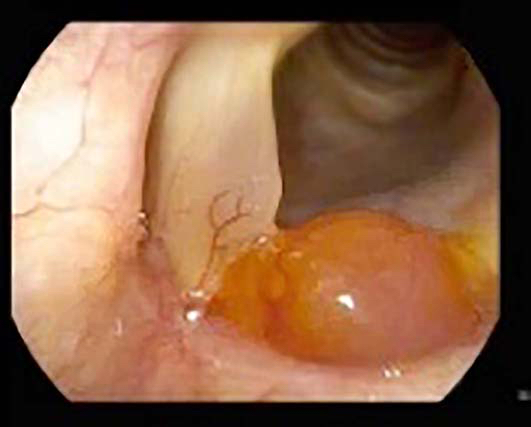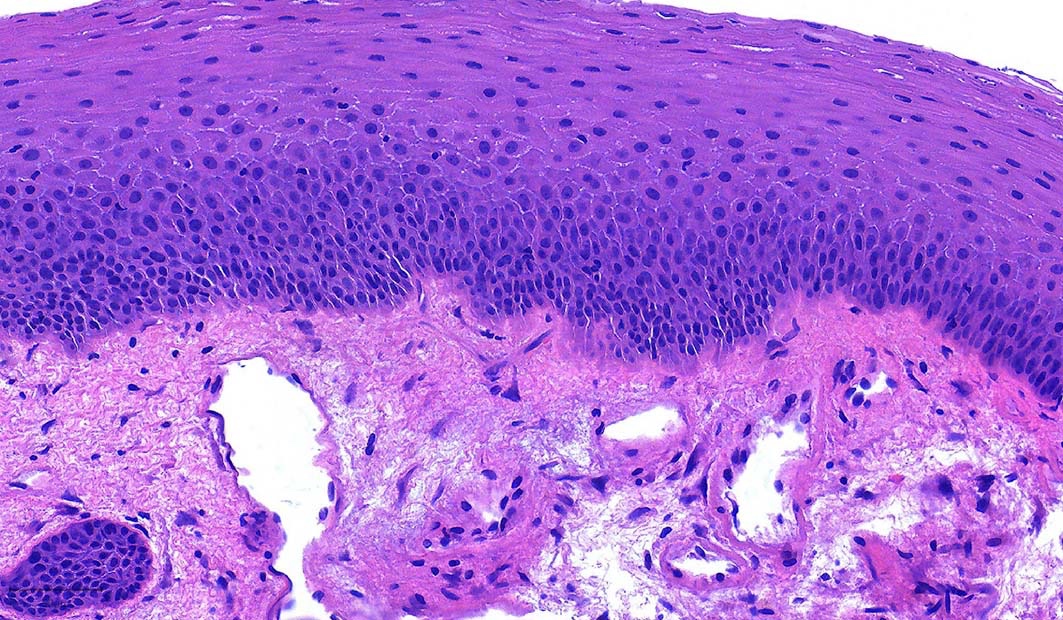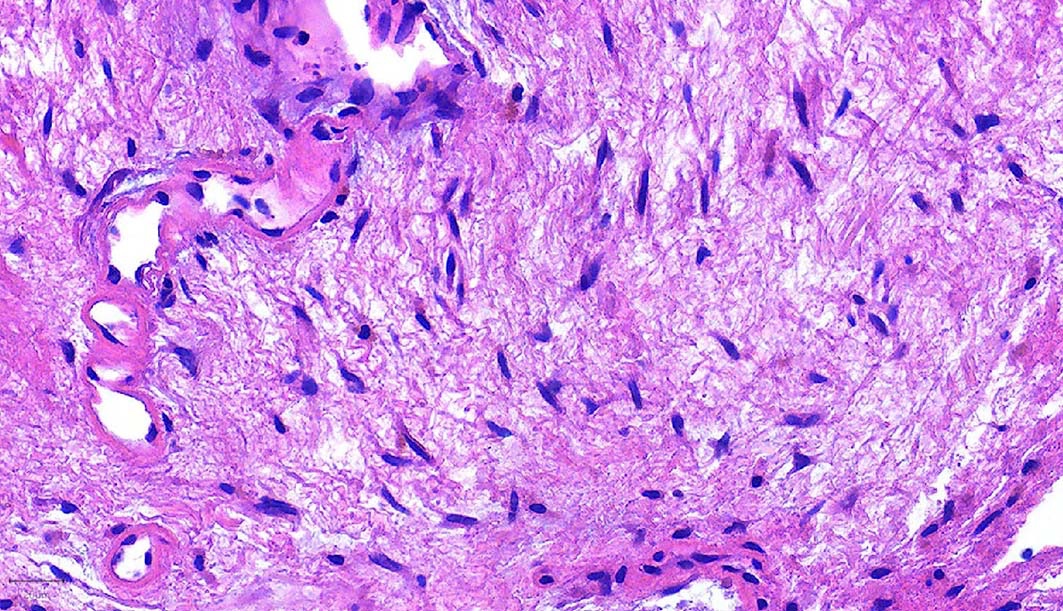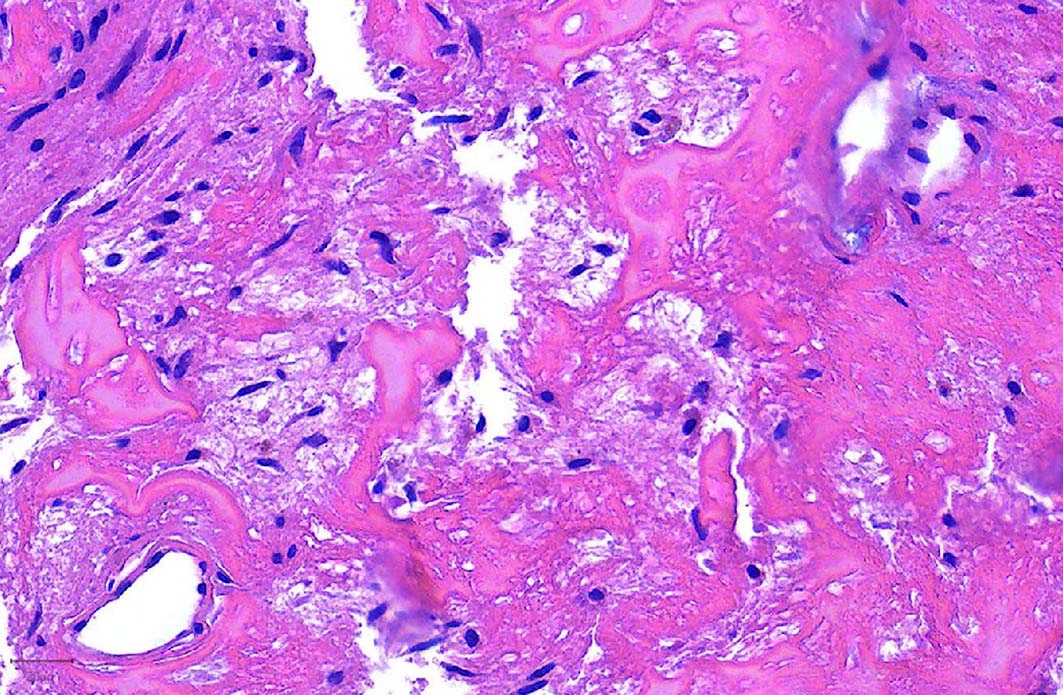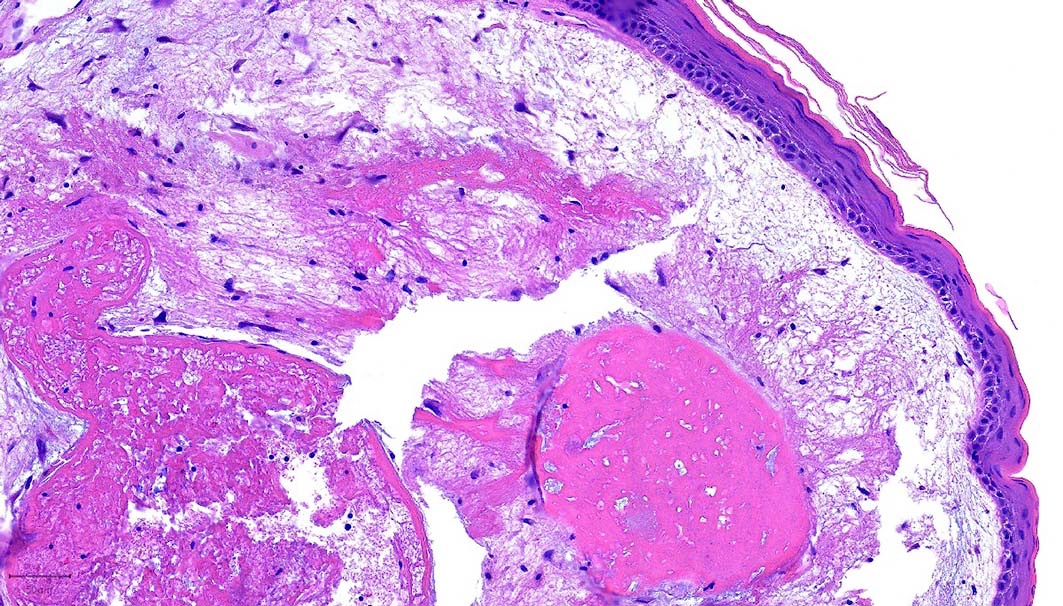Table of Contents
Definition / general | Essential features | Terminology | Epidemiology | Sites | Clinical features | Diagnosis | Case reports | Treatment | Clinical images | Gross description | Microscopic (histologic) description | Microscopic (histologic) images | Negative stains | Sample pathology report | Differential diagnosis | Practice question #1 | Practice answer #1 | Practice question #2 | Practice answer #2Cite this page: Chatzopoulos K. Vocal cord polyp. PathologyOutlines.com website. https://www.pathologyoutlines.com/topic/larynxvocalcordpolyp.html. Accessed September 16th, 2025.
Definition / general
- Common benign laryngeal lesion, also known as laryngeal nodule or singer's nodule
- Clinical terms: nodule (sessile) versus polyp (pedunculated) (J Voice 2004;18:125)
Essential features
- Benign exophytic, pedunculated (polyp) or sessile (nodule) lesion of the vocal cord, frequently related to voice overuse or irritation, lined by unremarkable squamous epithelium or with mild reactive atypia, overlying an edematous, myxoid or hyalinized fibroblastic stroma with telangiectatic vessels
Terminology
- Laryngeal nodule, singer's nodule, Reinke edema
Epidemiology
- Patients of all ages, even in pediatric population (Otolaryngol Clin North Am 2019;52:657)
- More common in heavy smokers, patients with history of chronic irritant inhalation or singers, due to inflammation, allergic or immunologic causes, possibly secondary to hemorrhage
- Can be secondary to irritation from gastroesophageal reflux disease (J Med Case Rep 2020;14:2)
Sites
- True vocal cords
Clinical features
- Hoarseness in patients with voice overuse or irritation (J Voice 2004;18:125)
Diagnosis
- Combination of clinical presentation, laryngoscopy findings and biopsy interpretation
Case reports
- 24 year old woman with laryngeal polyp secondary to gastroesophageal reflux disease (J Med Case Rep 2020;14:2)
- 35 year old man with a large laryngeal polyp secondary to voice overuse (Ear Nose Throat J 2011;90:E30)
- 47 year old man with longstanding hoarseness, increasing stridor and deteriorating shortness of breath (Ann Emerg Med 2016;68:421)
Treatment
- Nodule: voice therapy, phonomicrosurgery or intralesional corticosteroid injection
- Polyp: similar as for nodule, plus angiolytic laser treatment (Otolaryngol Clin North Am 2019;52:745)
Gross description
- Smooth, round, 1 - 3 mm growths on true vocal cords, often on anterior third
Microscopic (histologic) description
- Polyps and nodules are histologically indistinguishable, although polyps tend to be larger (J Voice 2004;18:125)
- Early stage lesions with myxoid edematous stromal changes and fibroblastic proliferation
- Later stage lesions with stromal hyalinization and telangiectatic blood vessels
- Overlying squamous mucosa is usually unremarkable or can show mild reactive atypia (J Med Case Rep 2020;14:2, Braz J Otorhinolaryngol 2013;79:434, J Voice 2004;18:125, J Laryngol Otol 1957;71:673)
Microscopic (histologic) images
Negative stains
Sample pathology report
- Larynx, left true vocal cord, biopsy:
- Vocal cord polyp
Differential diagnosis
- Lobular capillary hemangioma (pyogenic granuloma):
- Subepithelial lobular capillary proliferation, frequently secondary to mechanical trauma during intubation (Otolaryngol Clin North Am 2019;52:657)
- Spindle cell carcinoma:
- Frequently presents as vocal cord polyp, atypical subepithelial spindle cells (stains for keratins, p63, p40 can be helpful) with mitotic activity and associated dysplasia of the overlying squamous mucosa (Diagn Pathol 2007;2:1)
- Inflammatory myofibroblastic tumor:
- Myofibroblastic spindle cell tumor, frequently ALK positive, with associated inflammatory component, usually plasma cell rich (Diagn Pathol 2007;2:1)
- Localized amyloidosis:
- Very rare, subepithelial congophilic amorphous deposits (Open Med (Wars) 2020;15:327)
- Cavernous hemangioma:
- Usually supraglottic, vessel walls are thicker and doesn't respond to vocal rest (J Craniofac Surg 2013;24:687)
- Myxoma:
- Uncommon in the larynx, stellate spindle cells in abundant myxoid background (Head Neck Pathol 2014;8:204)
- Neurofibroma:
- Rare in the larynx, usually supraglottic localization in patients with neurofibromatosis type 1 (Arch Otolaryngol Head Neck Surg 2004;130:1400)
Practice question #1
Which of the following is the most helpful diagnostic clue in the differential diagnosis of vocal cord polyp from spindle cell carcinoma?
- Dysplasia in the superficial squamous mucosa
- Immunoreactivity for keratins AE1 / AE3
- Presence of atypical stromal cells
- Telangiectatic blood vessels in the stroma
Practice answer #1
A. Dysplasia in the superficial squamous mucosa of a polypoid laryngeal lesion should prompt the differential diagnosis of spindle cell carcinoma. The squamous mucosa of vocal cord polyps is usually unremarkable or can show mild atypia. Nonspecific immunostaining of keratins AE1 / AE3 in stomal fibroblasts or the presence of bizarre stromal cells can be diagnostic pitfalls, especially in the absence of overt dysplasia. Telangiectatic blood vessels can be seen in the stroma of both vocal cord polyps and spindle cell carcinomas.
Comment Here
Reference: Vocal cord polyp
Comment Here
Reference: Vocal cord polyp
Practice question #2
Practice answer #2
B. Congo red histochemical stain is a low cost, sensitive method of screening specimens for amyloid, although interpretation needs the use of special polarizing lenses. The remaining methods, although more specific, are much more expensive and their use should be reserved for the further workup of specimens with confirmed amyloidosis.
Comment Here
Reference: Vocal cord polyp
Comment Here
Reference: Vocal cord polyp


